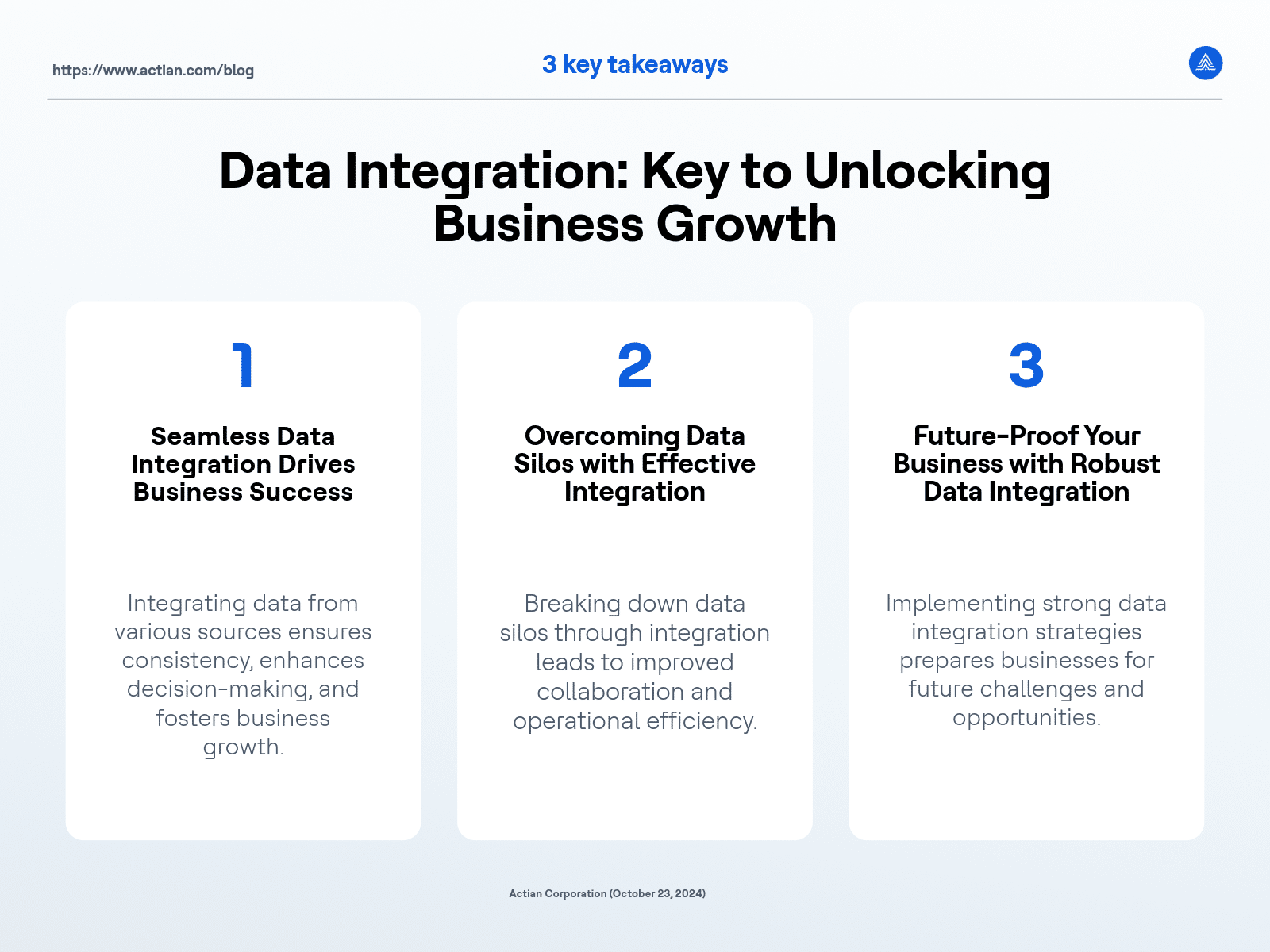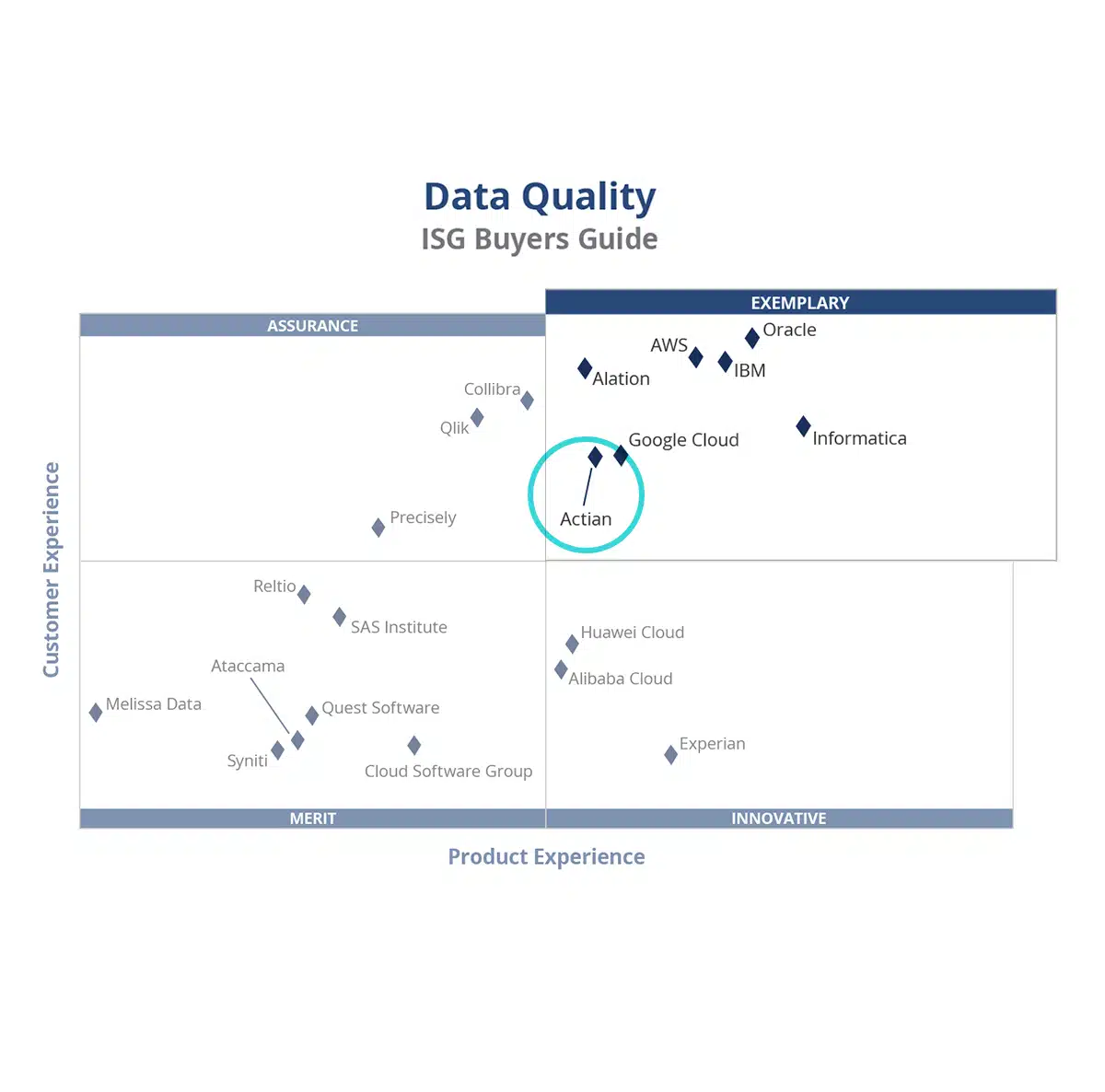Data Integration: The Key to Unlocking Business Growth
Successful data integration is the foundation of improving collaboration and coordination between business practices and processes. Supporting data integration not only helps the performance of the business in its entirely but the performance of individual functions in the business that need to utilize integrated trusted data for the needs of service delivery and service support of customers. Data integrity for decisions and well as enabling data integration tools to become critical for business success.
Businesses have managing and strategic functions and practices; operating or delivery functions and practices; supporting business functions and practices. Each of these practices has unique data needs that are only necessary for their practice areas but have to work and be integrated into the value chain of interactions that occur between them for the company’s success. This also helps eliminate constraints for the delivery and support of services when data hand-offs are efficient and effective in the organization. Data utilized between functional units should not be misinterpreted or subject to unneeded transformations to be useful for the operating team. Successful data integration makes organizational collaborations easier.
What is Data Integration?
Data integration is the strategic practice of consolidating data from disparate sources internally and externally of the organization and unifying that data as meaningful and valuable information. This data can be stored in various ways, such as in a data lake or data warehouse. Data integrations help evolve data by improving data content health, improving functional practice integrations, and improving overall data analytics for decision support.
No data can sit on an island by itself without integration without other data for value. Data integration of all the various types and forms of data is essential for organizations to understand their customers, environments, markets, and themselves.
All organizations use data. Data is mined for different purposes within the same organization and outside of the organization by other organizations. Data reveals information and knowledge based on the intended audience. Data supports results-driven decisions. Automation of data improves the performance of results-driven decisions. But care has to be taken into consideration of how data is used. Just as good data can be enabled by automation can improve good performance. Bad data enabled with automation can result in the faster demise of an organization with bad decisions.
The data integration approach to strategy, tactics, and operations has to be constantly audited and improved. Data and data sources can change in an instant as a response to many different circumstances. It is essential for organizations to realize this and implement proper governance and controls of their data and the external data they consume.
How Data Integration Benefits Business
Data integration benefits the top-line and the bottom-line of an organization. The top-line, which is focused on sales and revenue, is supported with data that helps drive improved sales and customer satisfaction. An organization that does not have insight into customers and their behaviors will not be as high-performing in service and product delivery as one that does. The bottom line, which is focused on expenses for operations, is supported with data that supports programs, projects, and asset utilization as well as human resources. An organization that works in silos may have shadow projects that manage data independently of the organization’s needs, resulting in bad decisions and wasted resources.
The benefits of data integration include:
- Scalability and high performance so more data can be delivered faster to enable timely decision making.
- Data profiling features ensure the business is using appropriate mechanisms for the data type, data volume and cardinality.
- For large data volumes, data transformation operations can be parallelized.
- Data quality can be assessed and managed.
- Opportunities for data reuse can be identified to reduce the overall amount of data that needs to be moved.
- Data integration services use real-time integration techniques, which complement traditional ETL technologies.
- Data flows can be scheduled centrally
- Data exceptions can be identified and handled before they negatively impact business decisions.
- Data use can be cataloged to provide data provenance to meet regulatory requirements.
Without data integration, data becomes siloed, and spreadsheet sprawl creates confusion about the most reliable data and results in poor decision-making.
The advantages of data integration in business intelligence can not be understated. A business should function as a team. Members are sharing data, communications, and actions relative to what the business needs instead of just what one function in the company wants to accomplish. Organizations that don’t have a data integration strategy will experience the end results of inneficiency, high costs, and noncompetitive services in the marketplace.
Data Integration in Modern Business
Business data integration can improve return on investment (ROI) and total cost of ownership (TCO) of the organization’s services and products. Doing this requires an investment in data integration as a strategy for the organization. The initial costs or value of investment (VOI) will affect the TCO. Still, the organization will experience immediate insights for decisions that they can realize immediately to increase the ROI or decrease the TCO of doing business.
The modern data integration strategies realize that data integration as a basis for improved decision support is mandatory. Business intelligence (BI) is rapidly becoming more popular. In order to support BI programs often used in sales, customer relationship management (CRM), marketing, and other areas, access to a diverse set of system data is required. My ensuring that data is integrated helps organizations make agile, continuous improvements to their products and services. Data integration has become a foundation for these practices combined with emerging technologies such as machine learning (ML), robotics, and artificial intelligence (AI).
Challenges of Data Integration
Challenges of data integration are typical challenges related to changing anything, especially from a strategy perspective. Listed are some of the data integration challenges:
- Executive support. Data integration is an investment in innovation for the organization. However, many organizational investment areas are in operational cost to run the business, fix issues and problems with current assets and capabilities, and business growth into existing or new markets. Innovation investment can create a competitive advantage and solve some of the issues experienced with the other investment areas.
- Understanding how decisions are made across the organizations and gaps in data for those decisions. This requires understanding what data is needed and what data is not needed within each functional unit. This also includes understanding how data exchanges work between functional units. Emphasis should be placed on making decisions more accessible and increasing the performance of the functional units in the organization.
- Determining source systems for data collection. This includes understanding gaps in data collection relative to decisions that need to be made within the organization. Data must be analyzed, extracted, transformed and loaded in a data repository that will be the source of truth for decisions.
- What technologies are needed. This includes what technologies are not required anymore. Technology reconciliations can be done once the understanding of how decisions are made using current tools and applications. This will contribute to TCO.
Besides the listed challenges in data integration, there is always the challenge related to people. Organizational change management, communication, governance, risk, and compliance must be considered for the data integration program. People have to buy in and be compliant about the changes and compassionate about how the changes affect them and the organization.
Data Integration Strategies
Data integration strategies should support the business strategy and be a sub-set of the overall IT strategy. Data integration should be continuous, as new systems and applications enter the organization. The organization should consider their data integration strategy in an agile way. Specific activities of data integration strategy should be:
- Understand business strategy, including vision, mission, and goals.
- Create a strategy for data integration which include:
- Performing data strategy assessment.
- Understanding of current operating model.
- Understand current data policies and processes.
- Do a strategic assessment.
- Understand the financial perspective and impacts.
- Understand current portfolio of service and products.
- Understand the demand for service and products.
- Understand Customer perspective of service and products.
- Create a data-driven business case.
- With strategic assessment data.
- Do strength, weakness, opportunities, and threats analysis (SWOT).
- Define market spaces.
- Identify strategic industry factors.
- Generate the strategy.
- Establish goals.
- Establish objectives.
- Create Key performance indicators (KPIs) and metrics.
- Create a strategic plan for input in tactical design and operations.
- Plan execution of data integration strategy relative to the strategic plan.
Once the strategic plan is complete, it should be backed up with tactics and operational programs, and projects to accomplish the plan. The strategic plan is a data-driven strategy to support how the organization makes decisions.
After the strategy is executed with tactics, tools and operational plans, integration teams should monitor and regularly evaluate opportunities for improvements to help achieve desired outcomes and results. The projects should include activities such as data migration. Projects can also include the creation of data lakes and data warehouses. If necessary, the concern should be given for a federated data strategy as a part of the overall data management strategy.
Data Integration Techniques
Data integration techniques begin with a design after the strategic plan is done. The plan articulates the outcomes needed for the organization. Data integration methods could include data mining techniques such as:
- Predictive Modeling Analysis – Ability to predict future events or outcomes.
- Deviation Detection Analysis – Ability to reveal surprising facts hidden under data.
- Decision Tree Analysis – Ability to consequence and chance modeling.
- Sequential Pattern Analysis – Ability to find subsequences.
- Fraud Detection Analysis – Ability to detect improper transactions.
- Financial Banking Analysis – Ability to evaluate economic trends.
- Weather Forecasting Analysis – Ability to evaluate weather trends.
- Stock Market Analysis – Ability to assess and investigate trading.
- Online Shopping Analysis – Ability to analyze customer patterns.
- Classification Analysis – Ability to assign categories to a collection of data.
Data integration techniques should be automated as much as possible without requiring manual intervention, but shouldn’t remove human oversight completely. Keep in mind that automation can improve ROI and actually lower operational costs while improving the organization’s performance, but automation without sufficient monitoring can lead to long term impacts
Some data integration techniques are:
- Manually done, driven by a user interface into the source systems.
- Done with existing applications to take advantage of new data sources within the application. Data can be kept in the source system, but it is best to move data to the application data source by application program interface (API) or data discovery solutions to populate the data at specific intervals. There are many database integration methods for utilizing and applying external data to applications.
- Using data lakes or data warehouses as common data storages to feed applications. Analytics is done at this level instead of at the application level that does not have this capability.
Organizations can be very creative with data integration techniques and architectures. It is always best to use complete off-the-shelf solutions (COTS) and especially cloud-based solutions to improve the overall solution’s time to value. When creating a data integration strategy, the primary focus should be business outcomes supported by technology. Spending too much time designing and developing custom solutions in this area will affect ROI and decrease overall VOI.
Data Integration Examples
Below are some use cases for data replication:
- Retailers use data replication to publish updated product pricing to stores and, conversely, receive store sales data for analysis in data warehouses/data platforms.
- Global financial reporting systems use CDC technology to extract data from country-level accounting systems for regional and regulatory filings.
- Mobile phone network operators use local call logs from cell towers to manage thequality of service (QoS) across their networks.
- Transportation companies fit their vehicles with GPS sensors to collect live locations for route optimization.
- Insurance companies use multi-step data integration to provide local reporting at branches using a uniform format. Consolidating this information at HQ provides sales
teams with industry benchmarks that differentiate policy management services. - Medical research uses data integration to collect clinical trial data that is aggregated and published centrally. This enables collaboration across the globe to fight disease.
Data Integration FAQs
Below are the answers to some common questions regarding data integration and management.
What’s the difference between data integration and ETL?
ETL stands for the “extract, transform, load” process, which takes information from various sources, transforms that data into a usable form, and loads it into a data receptacle. It can
be a key component of your overall data integration strategy.
What are the four data integration methodologies?
The four main methods of data integration include application-based data integration (which happens at the app level), virtualization (in which companies can virtually access their
various data stores without having to actually transfer information from those data repositories), change data capture (which tracks and synchronizes changes made to data
across multiple channels), and middleware integration (which uses a “middleman” software system to provide integration solutions).
Why is data integration necessary?
The process of data integration makes accessing data across company-wide channels much simpler, easier, and ubiquitous. It enables data-driven decision-making, paving the
way for more accurate and profitable business decisions, and allows systems interoperability. Without data integration, businesses operate significantly less efficiently and
are often unable to make the most appropriate adjustments to the market.
Data Integration Using Actian Solutions
Data is everywhere and growing faster than ever. Organizations have to have a data integration strategy to successfully understand the people, customers, and world around us. Without this understanding through the acquisition and integration of data and its successful usage of the data, organizational decisions can be flawed, resulting in the organization becoming out of touch or optional to its customers and its suppliers and employees. Data and analytics are the supporting foundations of all organizations.
The Actian Data Platform supports many of the above use cases. The Actian Data Platform has built-in connectors to hundreds of data sources, including cloud-based applications such as Salesforce and NetSuite. A universal adapter makes it easy to create custom interfaces for legacy applications making it easy to manage existing integration jobs along with new
ones.
Contact us to learn more about how Actian’s data management solutions can help grow your business.
Key Takeaways




